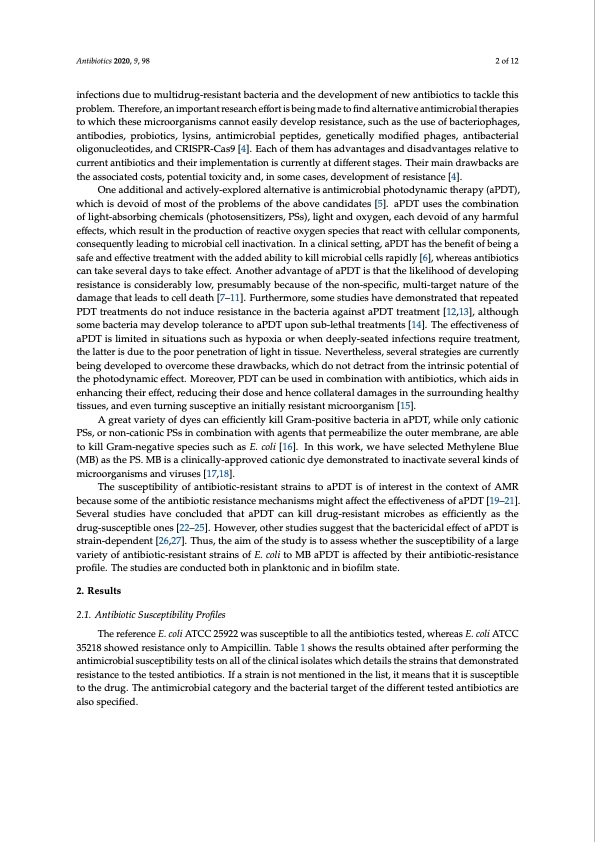
PDF Publication Title:
Text from PDF Page: 002
Antibiotics 2020, 9, 98 2 of 12 infections due to multidrug-resistant bacteria and the development of new antibiotics to tackle this problem. Therefore, an important research effort is being made to find alternative antimicrobial therapies to which these microorganisms cannot easily develop resistance, such as the use of bacteriophages, antibodies, probiotics, lysins, antimicrobial peptides, genetically modified phages, antibacterial oligonucleotides, and CRISPR-Cas9 [4]. Each of them has advantages and disadvantages relative to current antibiotics and their implementation is currently at different stages. Their main drawbacks are the associated costs, potential toxicity and, in some cases, development of resistance [4]. One additional and actively-explored alternative is antimicrobial photodynamic therapy (aPDT), which is devoid of most of the problems of the above candidates [5]. aPDT uses the combination of light-absorbing chemicals (photosensitizers, PSs), light and oxygen, each devoid of any harmful effects, which result in the production of reactive oxygen species that react with cellular components, consequently leading to microbial cell inactivation. In a clinical setting, aPDT has the benefit of being a safe and effective treatment with the added ability to kill microbial cells rapidly [6], whereas antibiotics can take several days to take effect. Another advantage of aPDT is that the likelihood of developing resistance is considerably low, presumably because of the non-specific, multi-target nature of the damage that leads to cell death [7–11]. Furthermore, some studies have demonstrated that repeated PDT treatments do not induce resistance in the bacteria against aPDT treatment [12,13], although some bacteria may develop tolerance to aPDT upon sub-lethal treatments [14]. The effectiveness of aPDT is limited in situations such as hypoxia or when deeply-seated infections require treatment, the latter is due to the poor penetration of light in tissue. Nevertheless, several strategies are currently being developed to overcome these drawbacks, which do not detract from the intrinsic potential of the photodynamic effect. Moreover, PDT can be used in combination with antibiotics, which aids in enhancing their effect, reducing their dose and hence collateral damages in the surrounding healthy tissues, and even turning susceptive an initially resistant microorganism [15]. A great variety of dyes can efficiently kill Gram-positive bacteria in aPDT, while only cationic PSs, or non-cationic PSs in combination with agents that permeabilize the outer membrane, are able to kill Gram-negative species such as E. coli [16]. In this work, we have selected Methylene Blue (MB) as the PS. MB is a clinically-approved cationic dye demonstrated to inactivate several kinds of microorganisms and viruses [17,18]. The susceptibility of antibiotic-resistant strains to aPDT is of interest in the context of AMR because some of the antibiotic resistance mechanisms might affect the effectiveness of aPDT [19–21]. Several studies have concluded that aPDT can kill drug-resistant microbes as efficiently as the drug-susceptible ones [22–25]. However, other studies suggest that the bactericidal effect of aPDT is strain-dependent [26,27]. Thus, the aim of the study is to assess whether the susceptibility of a large variety of antibiotic-resistant strains of E. coli to MB aPDT is affected by their antibiotic-resistance profile. The studies are conducted both in planktonic and in biofilm state. 2. Results 2.1. Antibiotic Susceptibility Profiles The reference E. coli ATCC 25922 was susceptible to all the antibiotics tested, whereas E. coli ATCC 35218 showed resistance only to Ampicillin. Table 1 shows the results obtained after performing the antimicrobial susceptibility tests on all of the clinical isolates which details the strains that demonstrated resistance to the tested antibiotics. If a strain is not mentioned in the list, it means that it is susceptible to the drug. The antimicrobial category and the bacterial target of the different tested antibiotics are also specified.PDF Image | Effective Photodynamic Inactivation of 26 E coli Strains

PDF Search Title:
Effective Photodynamic Inactivation of 26 E coli StrainsOriginal File Name Searched:
antibiotics-09-00098-v2.pdfDIY PDF Search: Google It | Yahoo | Bing
Cruise Ship Reviews | Luxury Resort | Jet | Yacht | and Travel Tech More Info
Cruising Review Topics and Articles More Info
Software based on Filemaker for the travel industry More Info
The Burgenstock Resort: Reviews on CruisingReview website... More Info
Resort Reviews: World Class resorts... More Info
The Riffelalp Resort: Reviews on CruisingReview website... More Info
| CONTACT TEL: 608-238-6001 Email: greg@cruisingreview.com | RSS | AMP |